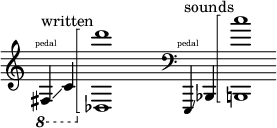
Back Euphonium ALS إيوفونيوم Arabic Bombardín AST Eufonium Azerbaijani Bombardí Catalan Eufonium Czech Euphonium Danish Euphonium German Eŭfono Esperanto Bombardino Spanish
This article needs additional citations for verification. (December 2022) |
 | |
| Brass instrument | |
|---|---|
| Classification | Aerophone |
| Hornbostel–Sachs classification | 423.232 (Valved aerophone sounded by lip movement) |
| Developed | 1840s from the ophicleide |
| Playing range | |
 | |
| Related instruments | |
| Part of a series on |
| Musical instruments |
|---|
The euphonium, also known as the baritone or aerophone, is a medium-sized, 3 or 4-valve, often compensating, conical-bore, tenor-voiced brass instrument that derives its name from the Ancient Greek word εὔφωνος euphōnos,[2] meaning "well-sounding" or "sweet-voiced" (εὖ eu means "well" or "good" and φωνή phōnē means "sound", hence "of good sound"). The euphonium is a valved instrument. Nearly all current models have piston valves, though some models with rotary valves do exist.
Euphonium music may be notated in the bass clef as a non-transposing instrument or in the treble clef as a transposing instrument in B♭. In British brass bands, it is typically treated as a treble-clef instrument, while in American band music, parts may be written in either treble clef or bass clef, or both.
A person who plays the euphonium is known as a euphoniumist, a euphonist, a euphophonist or simply a euphonium player.
- ^ Herbert, Myers & Wallace 2019, p. 484, Appendix 2: The Ranges of Labrosones.
- ^ "Euphonium". Merriam-Webster. Archived from the original on 31 January 2013. Retrieved 26 May 2012.